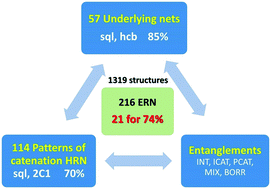How 2-periodic coordination networks are interweaved: entanglement isomerism and polymorphism†
Abstract
The entanglements of 1319 2-periodic coordination polymers are examined and fully classified using the extended ring nets (ERNs) approach. The ERNs characterize the entanglement to the greatest detail ever achieved: all possible classes/types/modes of entanglements observed and reported in the literature so far result in 216 ERN topologically distinct modes of entanglements with 74% of all the structures falling into only 21 of them. We also introduce the notion of entanglement isomerism to designate the coordination polymers that have the same chemical composition, local and overall topology, but differ by their catenation patterns as mapped into their ERNs.

- This article is part of the themed collection: 2017 Highlight article collection


 Please wait while we load your content...
Please wait while we load your content...